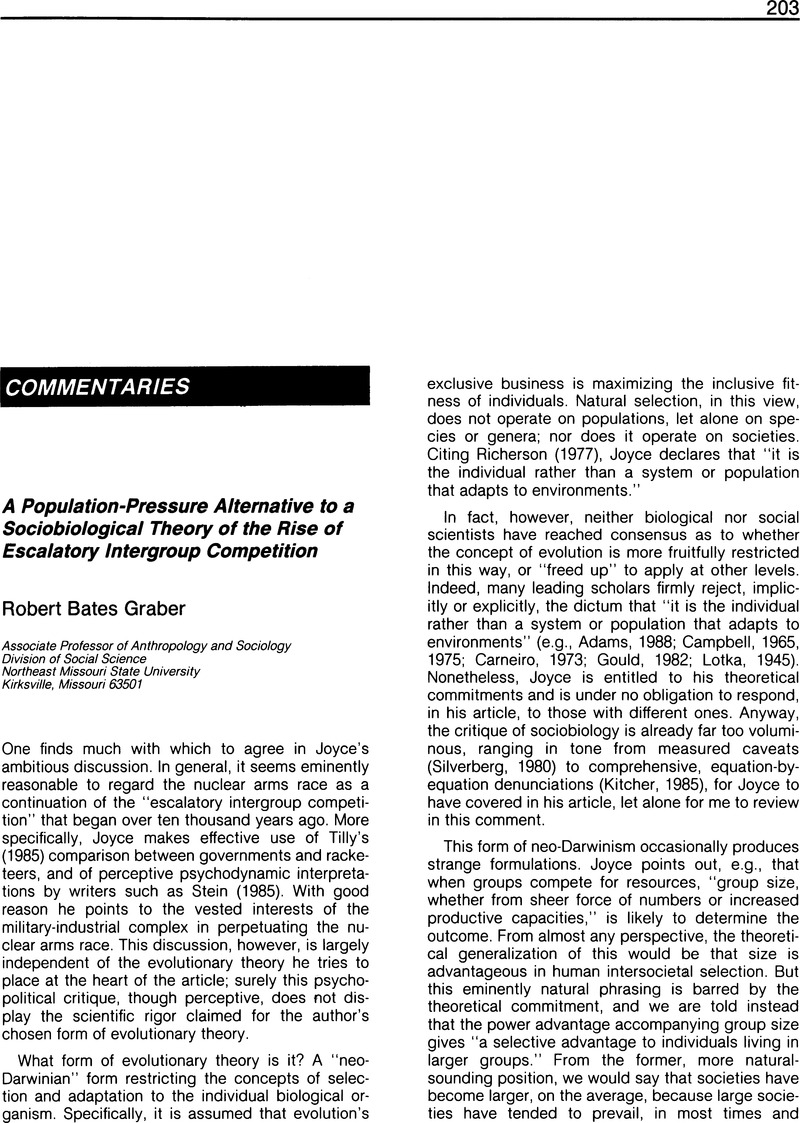Article contents
A Population-Pressure Alternative to a Sociobiological Theory of the Rise of Escalatory Intergroup Competition
Published online by Cambridge University Press: 17 May 2016
Abstract

- Type
- Articles and Commentaries
- Information
- Copyright
- Copyright © Association for Politics and the Life Sciences
References
Notes
1. The argument that societal growth and complexity enhance inclusive fitness of individuals appears less than overwhelming, even when restricted to elites. Thus, we learn thatBetzig, (1982) makes a good case for emergent states, but finds the effect disappearing in modern industrial states. Climaxing his argument, however, Joyce makes much of data purporting just such an effect in the U.S. today— namely, Essock-Vitales's (1984) finding regarding reproduction among 400 people in the U.S. with assets in excess of 250 million dollars. Admitting the sketchiness of data on distribution of wealth, one nonetheless can estimate that this figure represents very roughly 5,000 times the average (cf. Kerbo, 1983:37). The rate of reproduction, on the other hand, is about 1.3 times the average. To a skeptic, the disparity between these ratios might well suggest that the significance of extreme wealth, surely in terms of modern function, and possibly in terms of origin, may be mainly non-reproductive.Google Scholar
In any case, sociobiology owes its existence to the notion of inclusive fitness, which has as its raison d'être, explanation of “altruistic” behaviors not biopsychologically beneficial to individual organisms; because wealth brings direct biopsychological benefits to individuals, it is not clear that sociobiology as such makes any special contribution to explaining acquisitiveness. Furthermore, the factor of 1.3 appears modest compared with intercultural and even religious-subcultural fertility differentials (Weeks, , 1986: 84, 267). For enhancing fitness, being a Hutterite, or even a Mormon, evidently is much better than being rich.Google Scholar
2. These “triggers” do not provide a convincing explanation of the timing of the onset of escalatory intergroup competition. Joyce envisions the Pleistocene as a period in which “escalatory intergroup competition” existed as a predisposition held in check for nearly two million years by certain constraints. Chief among these, he believes, was the presumed reproductive advantage, for individuals, of living in small groups, which could efficiently focus on K-selected megafauna without overhunting them. Alternative, r-selected resources were available, but were not the focus of subsistence despite their relatively great productivity. Why it was only later that it became reproductively adaptive for individuals to live in larger groups and exploit such r-selected resources remains unclear. Joyce proposes that the transition would have been disadvantageous for individuals, prior to the end of the Pleistocene, due to the burden of “developing the necessary technology and information.” Yet this fails to convince, because some degree of exploitation of such resources already was occurring, so that such “early shifters” would have by no means been starting from scratch in developing the necessary tools and techniques. Indeed, it would seem equally—if not more—convincing, sociobiologically, to argue that “early shifters” would have enhanced their inclusive fitness by making such a shift they had in effect already begun. But since that is not what happened, the explanation must be tailored to fit what did happen. When Pleistocene people lived in small groups, that was adaptive (in terms of individuals' inclusive fitness); when post-Pleistocene people lived in larger groups, that had become adaptive (in terms of individuals' inclusive fitness). This is suspiciously post hoc, and has the sound of a Panglossian “adaptive story” (Gould, and Lewontin, , 1979).Google Scholar
- 3
- Cited by




